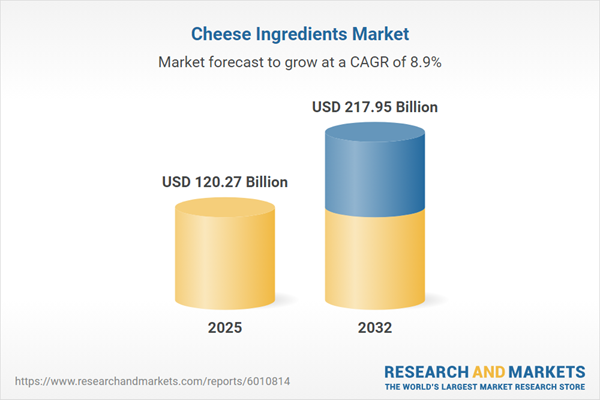Speak directly to the analyst to clarify any post sales queries you may have.
The cheese ingredients market is experiencing rapid evolution as senior leaders confront stricter regulations and new sourcing imperatives. To secure operational efficiency, maintain compliance, and achieve sustained competitiveness, access to focused market intelligence is now a primary requirement for decisive action and forward-looking strategy.
Market Snapshot: Cheese Ingredients Market Trends and Growth Outlook
The cheese ingredients market continues its growth trajectory, underpinned by industry expansion and shifting consumer behaviors. Strong demand for clean-label cheese products and transparent ingredient sourcing propels companies to reengineer manufacturing practices and solidify supply chain relationships. Regulatory pressure around ingredient traceability and safety is shaping current industry standards, with manufacturers adopting advanced production technologies and reinforcing supply chain protocols. In both established and emerging markets, foodservice providers and manufacturers expect higher product quality and visibility across all procurement stages, driving the market toward greater resilience and agility for established players and new entrants alike.
Scope & Segmentation of the Cheese Ingredients Market
This executive-level report delivers targeted intelligence to drive strategic decisions across the cheese ingredients value chain. Expert insights focus on innovation, supply responsiveness, and evolving dynamics from global markets to local operations.
- Ingredient Types: Starter cultures, enzymes, milk powders, salts, flavor enhancers, stabilizers, emulsifiers, and whey powders—all fundamental to compliance and product differentiation amid changing market needs.
- Form Factors: Choices include granular, liquid, and powdered options, each influencing process optimization and distribution strategies in partnership with suppliers and distributors.
- Distribution Channels: Evaluation covers both online and offline procurement models, with an emphasis on operational agility, automation, and partnership development as industry expectations evolve.
- End Uses: Analysis spans foodservice, large-scale and small-scale manufacturing, retail supermarkets, and convenience formats, highlighting the impact of changing consumer expectations on sourcing and product planning.
- Applications: The report addresses cream cheese as well as natural and processed cheeses—including cheddar, gouda, mozzarella, swiss—providing innovation roadmaps and portfolio alignment within the cheese sector.
- Regional Coverage: Comprehensive research encompasses the Americas, Europe, Middle East and Africa, and Asia-Pacific. Regulatory requirements, logistics complexity, and consumer expectations are dissected for each market to guide regional strategies.
- Leading Companies: Profiles of CHR. HANSEN A/S, DUPONT NUTRITION & BIOSCIENCES, KONINKLIJKE DSM N.V., KERRY GROUP PLC, CARGILL, INGREDION INCORPORATED, LAND O’LAKES, GIVAUDAN SA, CORBION N.V., and ARLA FOODS AMBA detail their innovation, value chain tactics, and influence on sector standards.
Key Takeaways: Strategic Insights for Senior Leaders
- Layering tailored ingredients enables firms to create unique cheese product offerings that match evolving taste, health, and sustainability expectations in both established and emerging segments.
- Implementing natural stabilizers and rigorous sourcing transparency supports statutory compliance and builds enduring trust with customers, especially in clean-label oriented and sustainability-driven markets.
- Adopting digital automation advances operational transparency, offering real-time insights that allow swift responses to potential disruptions within production and the wider supply network.
- Developing robust supplier relationships accelerates regulatory compliance and fosters innovation, ensuring rapid adaptation as new legislation or food standards emerge.
- Pursuing localized sourcing and flexible distribution configurations increases supply chain reliability, protecting business continuity from region-specific risks and regulatory shifts.
Tariff Impact: Navigating US Trade Policy Adjustments
Recent adjustments to U.S. trade policy are prompting cheese ingredient suppliers to expand domestic sourcing and capacity. Procurement teams are strengthening supplier diversification and operational agility to maintain ingredient availability and regulatory compliance as trade and market conditions evolve.
Methodology & Data Sources
This market research is built on in-depth interviews with industry specialists, analysis of technical and academic literature, exclusive datasets, and detailed sector investigations. Peer review validates all findings, ensuring actionable intelligence for senior decision-makers in the cheese ingredients market.
Why This Report Matters
- Equips executive teams with research-based insights to optimize technology adoption, procurement, and compliance protocols across the cheese ingredients value chain.
- Enables leaders to benchmark strategy, assess evolving sector risk, and align processes with shifting regulatory frameworks through sharply segmented market intelligence.
- Offers guidance for streamlining supply chain operations to address both international market fluctuations and regionally specific operational demands.
Conclusion
This report delivers actionable insight for senior leaders, advancing innovation, enhancing compliance capabilities, and fortifying supply chain resilience in the dynamic cheese ingredients sector.
Additional Product Information:
- Purchase of this report includes 1 year online access with quarterly updates.
- This report can be updated on request. Please contact our Customer Experience team using the Ask a Question widget on our website.
Table of Contents
3. Executive Summary
4. Market Overview
7. Cumulative Impact of Artificial Intelligence 2025
Companies Mentioned
The companies profiled in this Cheese Ingredients market report include:- CHR. HANSEN A/S
- DUPONT NUTRITION & BIOSCIENCES, INC.
- KONINKLIJKE DSM N.V.
- KERRY GROUP PLC
- CARGILL, INCORPORATED
- INGREDION INCORPORATED
- LAND O'LAKES, INC.
- GIVAUDAN SA
- CORBION N.V.
- ARLA FOODS AMBA
Table Information
| Report Attribute | Details |
|---|---|
| No. of Pages | 194 |
| Published | November 2025 |
| Forecast Period | 2025 - 2032 |
| Estimated Market Value ( USD | $ 120.27 Billion |
| Forecasted Market Value ( USD | $ 217.95 Billion |
| Compound Annual Growth Rate | 8.8% |
| Regions Covered | Global |
| No. of Companies Mentioned | 11 |









